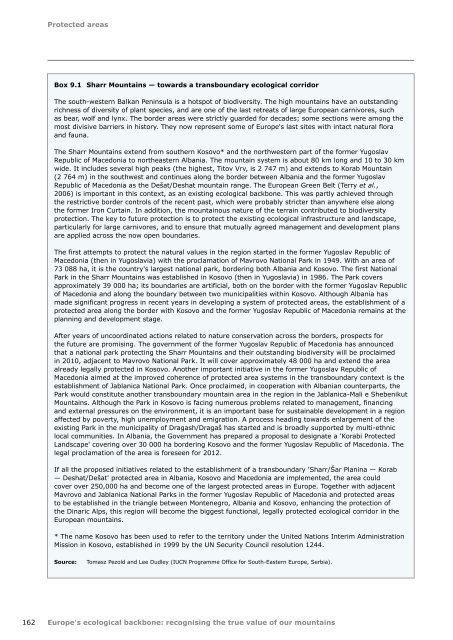Europes ecological backbone.pdf
Europes ecological backbone.pdf
Europes ecological backbone.pdf
Create successful ePaper yourself
Turn your PDF publications into a flip-book with our unique Google optimized e-Paper software.
Protected areas<br />
Box 9.1 Sharr Mountains — towards a transboundary <strong>ecological</strong> corridor<br />
The south-western Balkan Peninsula is a hotspot of biodiversity. The high mountains have an outstanding<br />
richness of diversity of plant species, and are one of the last retreats of large European carnivores, such<br />
as bear, wolf and lynx. The border areas were strictly guarded for decades; some sections were among the<br />
most divisive barriers in history. They now represent some of Europe's last sites with intact natural flora<br />
and fauna.<br />
The Sharr Mountains extend from southern Kosovo* and the northwestern part of the former Yugoslav<br />
Republic of Macedonia to northeastern Albania. The mountain system is about 80 km long and 10 to 30 km<br />
wide. It includes several high peaks (the highest, Titov Vrv, is 2 747 m) and extends to Korab Mountain<br />
(2 764 m) in the southwest and continues along the border between Albania and the former Yugoslav<br />
Republic of Macedonia as the Dešat/Deshat mountain range. The European Green Belt (Terry et al.,<br />
2006) is important in this context, as an existing <strong>ecological</strong> <strong>backbone</strong>. This was partly achieved through<br />
the restrictive border controls of the recent past, which were probably stricter than anywhere else along<br />
the former Iron Curtain. In addition, the mountainous nature of the terrain contributed to biodiversity<br />
protection. The key to future protection is to protect the existing <strong>ecological</strong> infrastructure and landscape,<br />
particularly for large carnivores, and to ensure that mutually agreed management and development plans<br />
are applied across the now open boundaries.<br />
The first attempts to protect the natural values in the region started in the former Yugoslav Republic of<br />
Macedonia (then in Yugoslavia) with the proclamation of Mavrovo National Park in 1949. With an area of<br />
73 088 ha, it is the country's largest national park, bordering both Albania and Kosovo. The first National<br />
Park in the Sharr Mountains was established in Kosovo (then in Yugoslavia) in 1986. The Park covers<br />
approximately 39 000 ha; its boundaries are artificial, both on the border with the former Yugoslav Republic<br />
of Macedonia and along the boundary between two municipalities within Kosovo. Although Albania has<br />
made significant progress in recent years in developing a system of protected areas, the establishment of a<br />
protected area along the border with Kosovo and the former Yugoslav Republic of Macedonia remains at the<br />
planning and development stage.<br />
After years of uncoordinated actions related to nature conservation across the borders, prospects for<br />
the future are promising. The government of the former Yugoslav Republic of Macedonia has announced<br />
that a national park protecting the Sharr Mountains and their outstanding biodiversity will be proclaimed<br />
in 2010, adjacent to Mavrovo National Park. It will cover approximately 48 000 ha and extend the area<br />
already legally protected in Kosovo. Another important initiative in the former Yugoslav Republic of<br />
Macedonia aimed at the improved coherence of protected area systems in the transboundary context is the<br />
establishment of Jablanica National Park. Once proclaimed, in cooperation with Albanian counterparts, the<br />
Park would constitute another transboundary mountain area in the region in the Jablanica-Mali e Shebenikut<br />
Mountains. Although the Park in Kosovo is facing numerous problems related to management, financing<br />
and external pressures on the environment, it is an important base for sustainable development in a region<br />
affected by poverty, high unemployment and emigration. A process heading towards enlargement of the<br />
existing Park in the municipality of Dragash/Dragaš has started and is broadly supported by multi‐ethnic<br />
local communities. In Albania, the Government has prepared a proposal to designate a 'Korabi Protected<br />
Landscape' covering over 30 000 ha bordering Kosovo and the former Yugoslav Republic of Macedonia. The<br />
legal proclamation of the area is foreseen for 2012.<br />
If all the proposed initiatives related to the establishment of a transboundary 'Sharr/Šar Planina — Korab<br />
— Deshat/Dešat' protected area in Albania, Kosovo and Macedonia are implemented, the area could<br />
cover over 250,000 ha and become one of the largest protected areas in Europe. Together with adjacent<br />
Mavrovo and Jablanica National Parks in the former Yugoslav Republic of Macedonia and protected areas<br />
to be established in the triangle between Montenegro, Albania and Kosovo, enhancing the protection of<br />
the Dinaric Alps, this region will become the biggest functional, legally protected <strong>ecological</strong> corridor in the<br />
European mountains.<br />
* The name Kosovo has been used to refer to the territory under the United Nations Interim Administration<br />
Mission in Kosovo, established in 1999 by the UN Security Council resolution 1244.<br />
Source:<br />
Tomasz Pezold and Lee Dudley (IUCN Programme Office for South-Eastern Europe, Serbia).<br />
162 Europe's <strong>ecological</strong> <strong>backbone</strong>: recognising the true value of our mountains

















